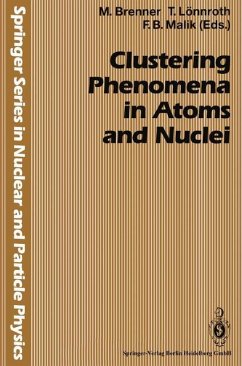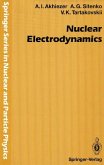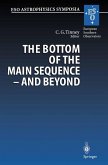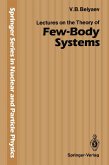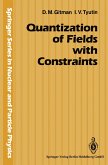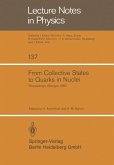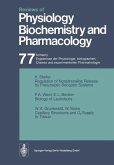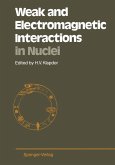Clustering Phenomena in Atoms and Nuclei
International Conference on Nuclear and Atomic Clusters, 1991, European Physical Society Topical Conference, Åbo Akademi, Turku, Finland, June 3-7, 1991
Herausgegeben:Brenner, Marten; Lönnroth, Tom; Malik, F.Bary
Clustering Phenomena in Atoms and Nuclei
International Conference on Nuclear and Atomic Clusters, 1991, European Physical Society Topical Conference, Åbo Akademi, Turku, Finland, June 3-7, 1991
Herausgegeben:Brenner, Marten; Lönnroth, Tom; Malik, F.Bary
- Broschiertes Buch
- Merkliste
- Auf die Merkliste
- Bewerten Bewerten
- Teilen
- Produkt teilen
- Produkterinnerung
- Produkterinnerung
In these days of specialization it is important to bring together physicists working in diverse areas to exchange and share their ideas and excitement. This leads to cross-fertilization of ideas, and it enriches, as in biological systems, a specialized field with new strength, development and direction derived from another area. Although this might be an uncommon thing, it is an important step in our under standing of the physical world around us, which is, after aIl, the main purpose of physics. The seed for this conference was really sowed when one of us (MB) and Mr. Manngärd showed some…mehr
Andere Kunden interessierten sich auch für
![Nuclear Electrodynamics Nuclear Electrodynamics]() Alexander AkhiezerNuclear Electrodynamics38,99 €
Alexander AkhiezerNuclear Electrodynamics38,99 €![The Bottom of the Main Sequence - And Beyond The Bottom of the Main Sequence - And Beyond]() The Bottom of the Main Sequence - And Beyond75,99 €
The Bottom of the Main Sequence - And Beyond75,99 €![Lectures on the Theory of Few-Body Systems Lectures on the Theory of Few-Body Systems]() Vladimir B. BelyaevLectures on the Theory of Few-Body Systems38,99 €
Vladimir B. BelyaevLectures on the Theory of Few-Body Systems38,99 €![Quantization of Fields with Constraints Quantization of Fields with Constraints]() Dmitri GitmanQuantization of Fields with Constraints107,99 €
Dmitri GitmanQuantization of Fields with Constraints107,99 €![From Collective States to Quarks in Nuclei From Collective States to Quarks in Nuclei]() From Collective States to Quarks in Nuclei39,99 €
From Collective States to Quarks in Nuclei39,99 €![Interacting Bosons in Nuclei Interacting Bosons in Nuclei]() Interacting Bosons in Nuclei39,99 €
Interacting Bosons in Nuclei39,99 €![Weak and Electromagnetic Interactions in Nuclei Weak and Electromagnetic Interactions in Nuclei]() Weak and Electromagnetic Interactions in Nuclei77,99 €
Weak and Electromagnetic Interactions in Nuclei77,99 €-
-
-
In these days of specialization it is important to bring together physicists working in diverse areas to exchange and share their ideas and excitement. This leads to cross-fertilization of ideas, and it enriches, as in biological systems, a specialized field with new strength, development and direction derived from another area. Although this might be an uncommon thing, it is an important step in our under standing of the physical world around us, which is, after aIl, the main purpose of physics. The seed for this conference was really sowed when one of us (MB) and Mr. Manngärd showed some a-scattering data at backward angles to FBM one summer about four years ago. That occasion led to a long research collaboration between the Abo Akademi physicists and other scientists in several countries. The actual idea to explore the possibility of holding a conference, however, crystallized in the summer of 1989 during a visit of FBM to Abo Akademi. The final decision to organize a conference was made after MB visited Profes sor Ben Mottelson in Copenhagen and Professor Anagnostatos in Athens. At this point it was recognized that there are similarities as weIl as differences between clustering phenomena in nuclei and systems consisting of atoms. It was therefore conjectured that it could be very stimulating to bring together these groups to exchange their ideas and to leam from each other's fields. A conference along these lines, we hoped, would contribute to an increased mutual understanding.
Produktdetails
- Produktdetails
- Springer Series in Nuclear and Particle Physics
- Verlag: Springer / Springer Berlin Heidelberg / Springer, Berlin
- Artikelnr. des Verlages: 978-3-662-02829-2
- Softcover reprint of the original 1st edition 1992
- Seitenzahl: 604
- Erscheinungstermin: 16. Januar 2013
- Englisch
- Abmessung: 235mm x 155mm x 33mm
- Gewicht: 914g
- ISBN-13: 9783662028292
- ISBN-10: 3662028298
- Artikelnr.: 39157832
- Herstellerkennzeichnung Die Herstellerinformationen sind derzeit nicht verfügbar.
- Springer Series in Nuclear and Particle Physics
- Verlag: Springer / Springer Berlin Heidelberg / Springer, Berlin
- Artikelnr. des Verlages: 978-3-662-02829-2
- Softcover reprint of the original 1st edition 1992
- Seitenzahl: 604
- Erscheinungstermin: 16. Januar 2013
- Englisch
- Abmessung: 235mm x 155mm x 33mm
- Gewicht: 914g
- ISBN-13: 9783662028292
- ISBN-10: 3662028298
- Artikelnr.: 39157832
- Herstellerkennzeichnung Die Herstellerinformationen sind derzeit nicht verfügbar.
I Clusters and Nuclei.- Shell Structure in Nuclei and in Metal Clusters.- Simple Models for Metal Clusters.- Electronic Shell Structure in Metal Clusters.- Quantum Chemical Interpretation of Absorption Spectra of Small Alkali Metal Clusters.- Effects of Crystal Field Splitting and Surface Faceting on the Electronic Shell Structure.- Fermion-Boson Classification in Microclusters.- Multipole Response of 3He Clusters.- Size-Dependent Plasmons in Small Metal Clusters.- Nucleonic Orbitals in the Valence Particle Plus Core Model of Nuclear Reactions.- Magic Numbers in Atomic Clusters: Energetic, Electronic and Structural Effects.- II Theoretical Approaches.- Medium Dependence in Heavy Ion Collisions.- Energy-Density Functional Formalism in Nuclear Physics.- An Inverse Scattering Theory for the Identical Particles and the 12C-12C Potential.- The Role of a Repulsive Core in the Investigation of Clusters in Light Nuclei.- Microscopic Versus Macroscopic Treatment of Clusters in Nuclei.- An Operator Interpolation Method for the Description of Intercluster Dynamics.- Pauli-Forbidden States and the Levinson Theorem in ? + ? Scattering.- Construction of Permutational Symmetry Adapted Non-Spurious States for Multi-Cluster Systems.- Correlated Basis Approach to Strong Interacting Systems.- Non-Closed-Shell Nuclear Clusters and the Algebraic Approach.- Microscopic Cluster Models for Nuclear Astrophysics.- The Visualization of the Energetic Structure of Nuclear Molecules.- Nuclear Structure Effects in Elastic and Inelastic Scattering of Light Ions.- III Cluster Radioactivity (f-Decay) and Fragmentation.- From Nuclear Molecules to Cluster Radioactivities.- Theories of Cluster Radioactivities.- Mechanism of the Spontaneous and Induced Two-Body Fragmentation of Heavy Nuclei.- ClusterRadioactivity and Nuclear Structure-Clusters as Solitons.- Cluster Radioactivity.- Observation of Nuclear Clusters in the Spontaneous Decay of Heavy Clusters.- Evidence of Spontaneous Emission of Oxygen Clusters from 228Th.- New Points of View on the Symmetric Fission of 258Fm.- Shell Model Approach to the Description of Cluster Radioactivity of Heavy Nuclei.- Exotic Cluster Decays and Reinforcing and Switching of Shell Gaps in Nuclei.- Alpha Widths in Deformed Nuclei: A Microscopic Approach.- Clusters in Nuclear Fission.- Excitation and Fission in Alkali-Atom Clusters.- Fragmentation of Doubly Charged Alkali-Metal Clusters.- Effects of Electronic and Atomic Shell Configurations on Fragmentations of Metal Clusters.- Spontaneous Decay of Ionized Atomic Clusters: Statistical and Non-Statistical Channels.- IV Clustering in Light Nucle.- Alpha-Nucleus Interaction Beyond Woods-Saxon.- Local Potential Description of Elastic Scattering and of Cluster Structure in Light Nuclei.- Alpha Clustering in Nuclei and the Structure of 44Ti.- General Regularities in Alpha-Particle-Nucleus Interaction and Cluster Structure of Light Nuclei.- Excitation Functions of Elastic Scattering of Alpha-Particles on Light Nuclei Measured in Reversed Geometry at Zero Degree.- High-Resolution Study of ?+28Si Elastic Scattering with a Cyclotron Fragmented ?-Cluster States?.- Semi-microscopic n?-Cluster Model for Light Nuclei.- Large Clusters in Light Nuclei.- Molecular Resonances in 24Mg Revealed in the 12C(20Ne, 12C12C)8Be Reaction.- Detection of 12C Fragments in the First Excited 0+ State-Nuclear Structure in 24Mg?.- The Properties of 28Si Resonances at the 31.5 MeV and 33.2 MeV Excitation Energies via the 24Mg(?, 12C)16O and 24Mg(?, ?)24Mg Reactions.- V Atomic Clusters and Ions.- Energeticsand Dynamics of Solvation and Fission in Clusters.- Role of Valence Electrons in the Structure and Properties of Microclusters.- Atomic Clusters and Inelastic Sputtering of Condensed Matter by Ions.- Precision Measurements of Atomic Masses Using Highly Charged Ions and Atomic Clusters.- Carbon Clusters from a Cs-Sputter Ion Source.- Atomic Structure and Magic Numbers for Cu Clusters at Elevated Temperatures.- Calculation of the Photoionization Cross Sections for Small Metal Clusters.- VI Reactions and Clusters.- Alpha Cluster Emission in Heavy Ion Fragmentation.- Peculiarities in Partial Cross Sections of Light Heavy-Ion Reactions - Evidence for Nuclear Molecules.- Multiply Charged Atomic Clusters.- Analytical Determination of the Microscopic N-N Interaction Potential - Applications to Cluster Transfer and Fusion Reactions.- Formation and Dissolution of Clusters Studied with Antisymmetrized Molecular Dynamics.- Cluster Degree of Freedom and Nuclear Reaction and Decay.- Competition Between Light Cluster and Constituent Multinucleon Emission in Heavy-Ion Nuclear Reactions.- Heavy-Cluster Transfer Reactions.- Collisions Between Atomic Clusters.- Cluster Transfer at Very Low Energies.- VII Post-Conference Thoughts.- Nuclear Versus Atomic Clusters.- Index of Contributors.
I Clusters and Nuclei.- Shell Structure in Nuclei and in Metal Clusters.- Simple Models for Metal Clusters.- Electronic Shell Structure in Metal Clusters.- Quantum Chemical Interpretation of Absorption Spectra of Small Alkali Metal Clusters.- Effects of Crystal Field Splitting and Surface Faceting on the Electronic Shell Structure.- Fermion-Boson Classification in Microclusters.- Multipole Response of 3He Clusters.- Size-Dependent Plasmons in Small Metal Clusters.- Nucleonic Orbitals in the Valence Particle Plus Core Model of Nuclear Reactions.- Magic Numbers in Atomic Clusters: Energetic, Electronic and Structural Effects.- II Theoretical Approaches.- Medium Dependence in Heavy Ion Collisions.- Energy-Density Functional Formalism in Nuclear Physics.- An Inverse Scattering Theory for the Identical Particles and the 12C-12C Potential.- The Role of a Repulsive Core in the Investigation of Clusters in Light Nuclei.- Microscopic Versus Macroscopic Treatment of Clusters in Nuclei.- An Operator Interpolation Method for the Description of Intercluster Dynamics.- Pauli-Forbidden States and the Levinson Theorem in ? + ? Scattering.- Construction of Permutational Symmetry Adapted Non-Spurious States for Multi-Cluster Systems.- Correlated Basis Approach to Strong Interacting Systems.- Non-Closed-Shell Nuclear Clusters and the Algebraic Approach.- Microscopic Cluster Models for Nuclear Astrophysics.- The Visualization of the Energetic Structure of Nuclear Molecules.- Nuclear Structure Effects in Elastic and Inelastic Scattering of Light Ions.- III Cluster Radioactivity (f-Decay) and Fragmentation.- From Nuclear Molecules to Cluster Radioactivities.- Theories of Cluster Radioactivities.- Mechanism of the Spontaneous and Induced Two-Body Fragmentation of Heavy Nuclei.- ClusterRadioactivity and Nuclear Structure-Clusters as Solitons.- Cluster Radioactivity.- Observation of Nuclear Clusters in the Spontaneous Decay of Heavy Clusters.- Evidence of Spontaneous Emission of Oxygen Clusters from 228Th.- New Points of View on the Symmetric Fission of 258Fm.- Shell Model Approach to the Description of Cluster Radioactivity of Heavy Nuclei.- Exotic Cluster Decays and Reinforcing and Switching of Shell Gaps in Nuclei.- Alpha Widths in Deformed Nuclei: A Microscopic Approach.- Clusters in Nuclear Fission.- Excitation and Fission in Alkali-Atom Clusters.- Fragmentation of Doubly Charged Alkali-Metal Clusters.- Effects of Electronic and Atomic Shell Configurations on Fragmentations of Metal Clusters.- Spontaneous Decay of Ionized Atomic Clusters: Statistical and Non-Statistical Channels.- IV Clustering in Light Nucle.- Alpha-Nucleus Interaction Beyond Woods-Saxon.- Local Potential Description of Elastic Scattering and of Cluster Structure in Light Nuclei.- Alpha Clustering in Nuclei and the Structure of 44Ti.- General Regularities in Alpha-Particle-Nucleus Interaction and Cluster Structure of Light Nuclei.- Excitation Functions of Elastic Scattering of Alpha-Particles on Light Nuclei Measured in Reversed Geometry at Zero Degree.- High-Resolution Study of ?+28Si Elastic Scattering with a Cyclotron Fragmented ?-Cluster States?.- Semi-microscopic n?-Cluster Model for Light Nuclei.- Large Clusters in Light Nuclei.- Molecular Resonances in 24Mg Revealed in the 12C(20Ne, 12C12C)8Be Reaction.- Detection of 12C Fragments in the First Excited 0+ State-Nuclear Structure in 24Mg?.- The Properties of 28Si Resonances at the 31.5 MeV and 33.2 MeV Excitation Energies via the 24Mg(?, 12C)16O and 24Mg(?, ?)24Mg Reactions.- V Atomic Clusters and Ions.- Energeticsand Dynamics of Solvation and Fission in Clusters.- Role of Valence Electrons in the Structure and Properties of Microclusters.- Atomic Clusters and Inelastic Sputtering of Condensed Matter by Ions.- Precision Measurements of Atomic Masses Using Highly Charged Ions and Atomic Clusters.- Carbon Clusters from a Cs-Sputter Ion Source.- Atomic Structure and Magic Numbers for Cu Clusters at Elevated Temperatures.- Calculation of the Photoionization Cross Sections for Small Metal Clusters.- VI Reactions and Clusters.- Alpha Cluster Emission in Heavy Ion Fragmentation.- Peculiarities in Partial Cross Sections of Light Heavy-Ion Reactions - Evidence for Nuclear Molecules.- Multiply Charged Atomic Clusters.- Analytical Determination of the Microscopic N-N Interaction Potential - Applications to Cluster Transfer and Fusion Reactions.- Formation and Dissolution of Clusters Studied with Antisymmetrized Molecular Dynamics.- Cluster Degree of Freedom and Nuclear Reaction and Decay.- Competition Between Light Cluster and Constituent Multinucleon Emission in Heavy-Ion Nuclear Reactions.- Heavy-Cluster Transfer Reactions.- Collisions Between Atomic Clusters.- Cluster Transfer at Very Low Energies.- VII Post-Conference Thoughts.- Nuclear Versus Atomic Clusters.- Index of Contributors.

